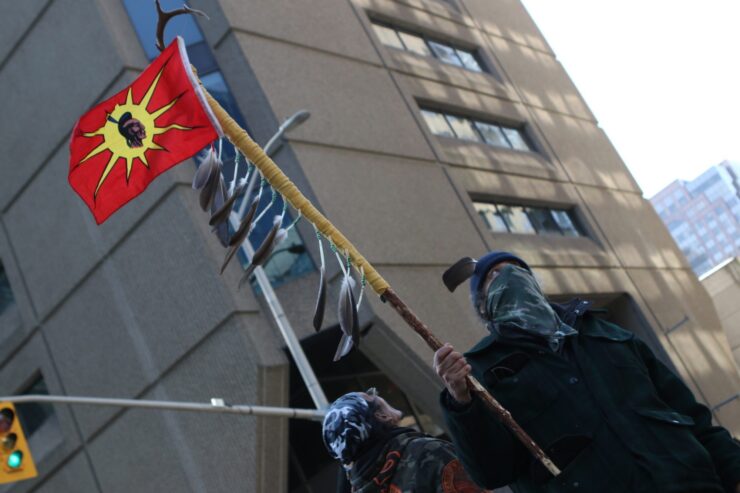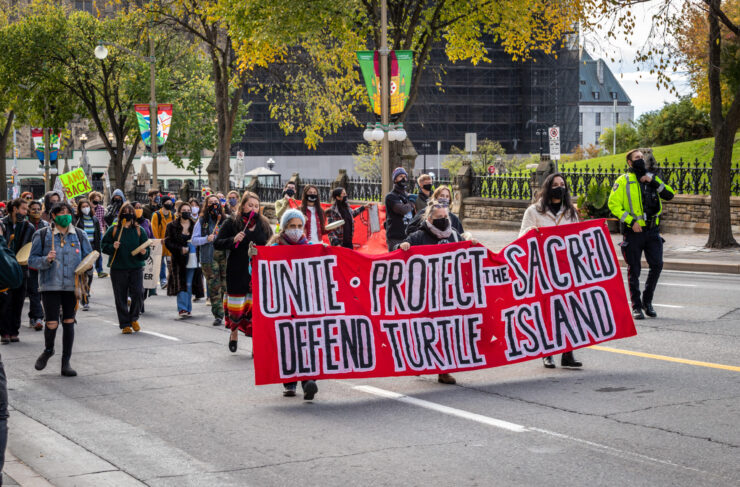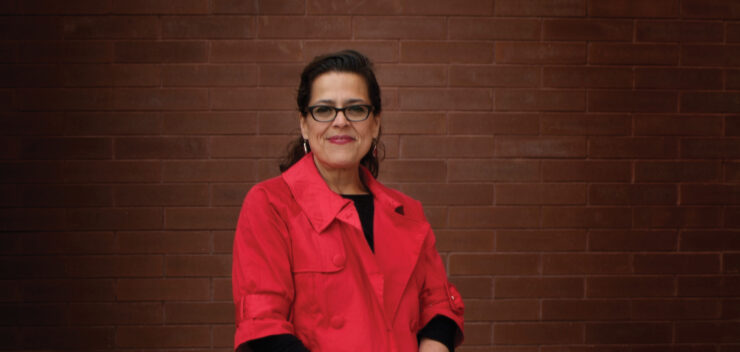Although the Truth and Reconciliation Commission (TRC) of Canada was significant in institutionalizing the history of colonialism and producing the 94 Calls to Action, it’s reception remains contentious among the diverse panoply of Indigenous groups.
The Indigenous-led NGO, Reconciliation Canada – A New Way Forward Society, one of the more vocal proponents of Indigenous collaboration with the TRC, frequently espouses the significance of “catalyz[ing] meaningful relationships through values-based dialogue, leadership, and action”
Coalitions skeptical of the colonial establishment, however, tend to err on the side of caution, instead highlighting their specific grievances with the settler-colonial state.
Particularly in light of the Canadian government’s still-ongoing violent seizure of unseeded Wet’suwet’en territory, the objectives of many Indigenous direct action groups appear reflective of the controversial axiom, “reconciliation is dead.”
For the sake of maintaining a concise outline, I will primarily focus on the social effects of the TRC as relevant to the extra-governmental movements concerned with grassroots mobilization.
Due to the varied perspectives presented by the overwhelming number of Indigenous groups, the rejection of reconciliation as embodied by the TRC diverges in its interpretation.
At the risk of reducing the totality of Indigenous struggle to a homogeneous monolith, it critiques can be outlined between two broad principles.
First, the concept of reconciliation originates in a colonial framework that tacitly legitimizes the same system that has been brutalizing them since first contact.
And second, that authentic decolonization—the ostensible aim of the TRC—is only feasible when the settler society of Canada has been rebuilt, thereby rejecting the politics of state recognition and negotiation.
Both perspectives view the TRC as a matter of optics, as an attempt to appease Indigenous groups with progressive talking points.
When you visit the Beyond 94 website, for example, eleven percent of the proposed “94 Calls to Action” have reached completion, with the remaining projects marked as ‘in-progress’ or ‘not yet started.’
Evidently, the TRC was an effort in historical record-keeping portrayed with the language of progressive policy-making and cultural reckoning: “on a spectrum between the poles of judicial prosecution on one end and pure information gathering on the other, Canada sits radically in the latter direction.”
It would appear that, after being met with all the fanfare of a watershed historical moment, the TRC has unfortunately proven ineffectual in fomenting the decolonized, Indigenous futurist society anticipated by its proponents.
Ronald Niezen’s Truth and Indignation: Canada’s Truth and Reconciliation Commission on Indian Residential Schools offers a critical assessment of the TRC’s social impact and its effects on the project of reconciliation.
When attempting to examine the TRC’s effects on society at large, Niezen observed that the public response has been minimal albeit for the rare Internet comment thread. Beyond the initial news coverage, editorials and thinkpieces post-TRC have been few and far between.
His description of the commission room is one of high emotion and shared trauma, ultimately isolated from the larger public and the state of Indigenous and non-Indigenous relations today.
Niezen also takes issue with the perpetrator-less proceedings of the commission, noting a seemingly infinite number of victims amidst a near-absence of individual offenders. The faceless culprit as embodied by the federal government appears as more of an “abstraction, a source of policy, funding, and administration putting forth nothing that attracts censure or gains traction with audiences.”
To instead assign the onus of responsibility to the church is to essentially scapegoat the brutalities of the Canadian government. Though the church does, without ambiguity, share responsibility for their role in the residential school system, Niezen argues that, “individual childhood narratives fix attention on the ‘crime in private life’—child abuse—considerably more than the ‘wrong in public life’—legislated assimilation.”
The TRC’s focus on the personal testimonies of individual victims distracts public attention and media coverage away from the continued forms of neglect and active suppression still inflicted upon Indigenous communities.
Despite their incongruent claims to land and resources (by virtue of their diverse interests), grassroots Indigenous advocacy groups appear to agree on an issue underlying the TRC and its associated rhetoric; that is, the predominant discourse surrounding its inception has inadvertently historicized colonial violence as if it is not a persistent issue in the modern-day.
The federal government’s attention towards the traumas provoked by the residential school system neglects to acknowledge that the schools were a singular facet in the broader colonial project of eugenically motivated assimilation.
Reconciliation understood as an ill-defined buzzword is ultimately based “on this distinction in history where the crimes of the past are no longer in operation, and what we’re now dealing with is just a bunch of wounded, injured native subjects,” wrote Andrew Bard Epstein in 2015.
Consequently, what is made apparent in the aftermath of the TRC is that truth and reconciliation are often conflated with one another but are distinctly individual entities.
On this upcoming National Day of Truth and Reconciliation, it is vital that we keep the best interests of our Indigenous communities in mind.
More importantly, we must uplift and empower those Indigenous voices that may be critical of reconciliation and hope to do better in the future.

Shann Chiu is a third-year English major originally from Toronto, ON. As an avid enthusiast of English literature and critical theory, she aspires to develop her skills in literary analysis within the U of O’s MA in English literature program in 2021.






